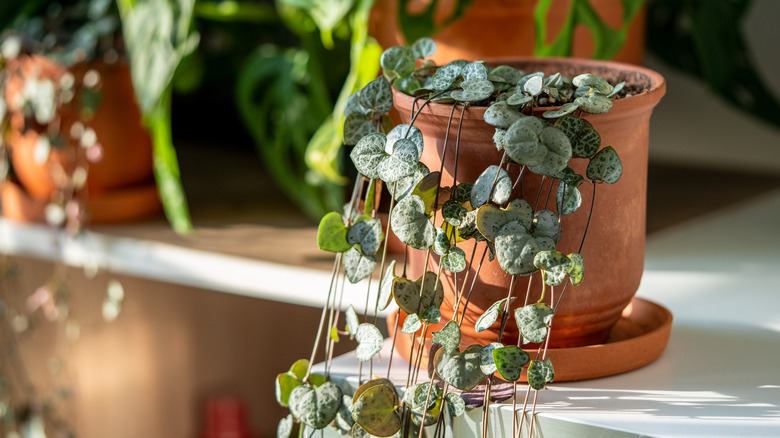Heed Our One Warning When Using String Of Hearts As A House Plant
Picture a trailing ivy hanging off a shelf in your kitchen or a variegated houseplant that cascades over the side of a built-in bookcase. It may seem like a plant-lover's dream, adding a touch of greenery and life to a room with very little effort; but the reality is often less than ideal. Many trailing plants grow faster and longer than anticipated, tangling themselves around furniture, spilling onto the floor, or spreading in directions that you didn't plan for. A lush, sprawling plant can be beautiful in the right space, but only if it remains an intentional design element. Without careful attention, a trailing plant can quickly feel messy and unkempt, rather than curated and stylish. Among these trialing varieties, the string of hearts stands out for its delicate vines and heart-shaped leaves that drape beautifully from their container. It's easy to admire and love within a space — but its charm comes with one important consideration.
The main warning when growing a string of hearts plant is to be mindful of its growth rate. These vines grow extremely quickly and can reach several feet in just a few months, spilling over the sides of shelves, getting into your cooking space, and reaching the floor in ways that aren't always practical. Instead of worrying if your string of hearts plant is dying, you're facing a situation where it may be doing a bit too well. Its rapid growth may demand regular attention to keep the plant itself manageable and visually appealing. Without this upkeep, your once tidy accent turns into a practical and aesthetic nightmare within your home. But how can you manage a string of heart plants without damaging it?
Creative ways to manage a string of hearts plant
Keeping a string of hearts looking elegant doesn't have to be complicated, but it does require consistent attention. Pruning is the most effective tool for controlling rapid growth while encouraging fuller, healthier vines. Most homeowners find that trimming every couple of months during the growing season keeps the plant looking neat without slowing its natural expansion. However, you can prune the plant on your schedule based on your plant's growth.
When pruning, it's best to cut just above a leaf node, which stimulates branching and ensures the plant maintains a bushy, full appearance rather than becoming sparse. Some gardeners plant the cuttings back into the pot to achieve a bushier appearance from their plant. You can use the cuttings to easily propagate in water or soil, creating new plants to grow in other areas of your home or share with friends. With a regular pruning routine, the string of hearts can remain a polished, controlled accent, rather than spilling chaotically over all of your spaces.
Beyond pruning, there are several creative ways to display the plant that both showcase its beauty and help manage its spread. For starters, you can opt for the easier to care for string of hearts dupe known as a Hoya curtisii. You can use a series of hanging baskets in the kitchen to keep your plants trailing into one another and stop potential pooling on countertops. When it starts to get in your way, you can prune it to the right size and shape. Another option is to create a wooden or moss trellis for the plant to grow on. Some homeowners create a circular shape, while others are content with a bit of vertical growth from their string of hearts.

